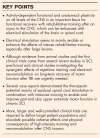Enhancing rehabilitation and functional recovery after brain and spinal cord trauma with electrical neuromodulation
- PMID: 31567546
- PMCID: PMC6855343
- DOI: 10.1097/WCO.0000000000000750
Enhancing rehabilitation and functional recovery after brain and spinal cord trauma with electrical neuromodulation
Abstract
Purpose of review: This review discusses recent advances in the rehabilitation of motor deficits after traumatic brain injury (TBI) and spinal cord injury (SCI) using neuromodulatory techniques.
Recent findings: Neurorehabilitation is currently the only treatment option for long-term improvement of motor functions that can be offered to patients with TBI or SCI. Major advances have been made in recent years in both preclinical and clinical rehabilitation. Activity-dependent plasticity of neuronal connections and circuits is considered key for successful recovery of motor functions, and great therapeutic potential is attributed to the combination of high-intensity training with electrical neuromodulation. First clinical case reports have demonstrated that repetitive training enabled or enhanced by electrical spinal cord stimulation can yield substantial improvements in motor function. Described achievements include regaining of overground walking capacity, independent standing and stepping, and improved pinch strength that recovered even years after injury.
Summary: Promising treatment options have emerged from research in recent years using neurostimulation to enable or enhance intense training. However, characterizing long-term benefits and side-effects in clinical trials and identifying patient subsets who can benefit are crucial. Regaining lost motor function remains challenging.
Figures



References
-
- Hale AC, Bohnert KM, Grekin R, Sripada RK. Traumatic brain injury in the general population: Incidence, mental health comorbidity, and functional impact. J Nerv Ment Dis 2019; 207:38–42. - PubMed
-
- Badhiwala JH, Wilson JR, Fehlings MG. Global burden of traumatic brain and spinal cord injury. Lancet Neurol 2019; 18:24–25. - PubMed
Publication types
MeSH terms
LinkOut - more resources
Full Text Sources
Medical
Research Materials

